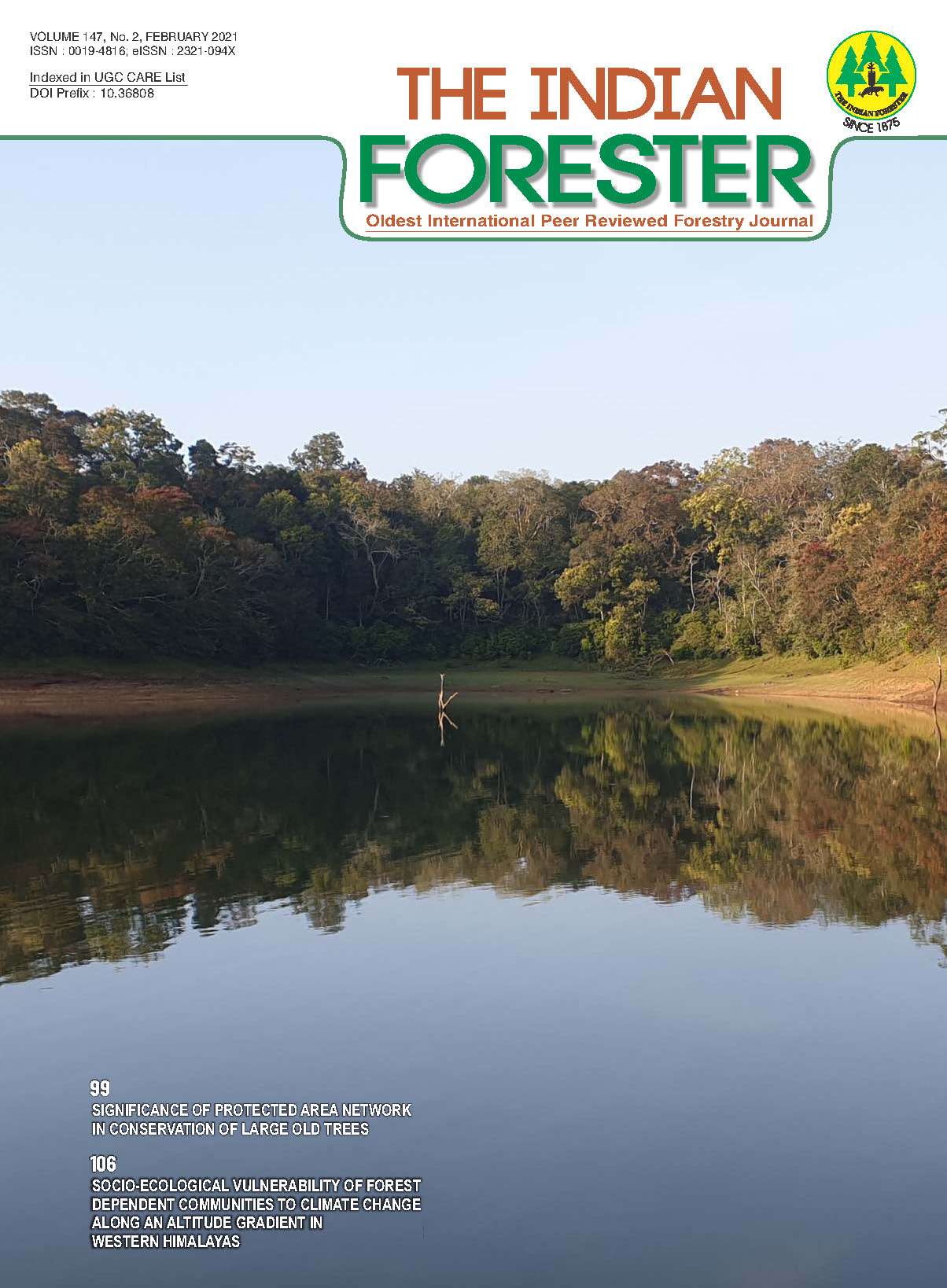Phenology and Morphometric Attributes of the Flower and Fruit of Cultivated Elaeocarpus angustifolius, the Rudraksha Plant from India
DOI:
https://doi.org/10.36808/if/2021/v147i2/156867Keywords:
Elaeocarpus angustifolius, Rudraksha, Phenology, Flower, Fruit, Morphometric Attributes.Abstract
The Elaeocarpus angustifolius Bl. (Syn. E. ganitrus Roxb. ex G. Don, E. sphaericus (Gaertn) K. Schume) occur naturally in various parts of India. The plant has poor regeneration in the wild and has been reported as a threatened species in the north-eastern region of India. This plant, known as Rudraksha in India, has been considered very sacred and pious for devotees in Hinduism. The descriptions made for this plant in the present article will further prove useful in correct identification of this plant. The input on phenological aspects will help in making strategies for conservation of this threatened and medicinally important Indian plant.References
Baba Y. (2013). Evolution, systematics and taxonomy of Elaeocarpus (Elaeocarpaceae) in Australia. Ph. D. Thesis, James Cook University, Australia, p 54.
Bhuyan P. (2002). Ecological studies on seed production, dispersal, germination and seedling fitness of Rudraksh (Elaeocarpus ganitrus Roxb.). Ph. D Thesis, Department of Botany, North-Eastern Hill University, Shillong, Meghalaya, India.
Blume C.L. (1825). Bijdragen tot de flora van Nederlandsch Indie. Ter Lands drukkerij, Batavia. Bijdr. 120.
Brandis D. (1921). Indian trees, British Indian Empire. Constable and Company Ltd., London. 4rth Impression, page 102.
Coode M.J.E. (1984). Elaeocarpus in Australia and New Zealand. Kew Bull., 39: 509-586.
Coode M.J.E. (2010). Elaeocarpus for Flora Malesiana: new taxa and understanding in the Ganitrus Group. Kew Bull., 3: 355-399.
Demarée G.R. and Rutishauser T. (2011). From Periodical Observations to Anthochronology and Phenology - the scientific debate between Adolphe Quetelet and Charles Morren on the origin of the word "Phenology. International Journal of Biometeorology. 55 (6): 753-761.
Don G. (1831). A general history of the dichlamydeous plants, Gen. Hist. , 1: 559.
Hardainiyan S. Nandi B.C. and Kumar K. (2015). Elaeocarpus ganitrus (Rudraksha): a reservoir plant with their pharmacological effects. Int. J. Pharm Sci. Rev. Res., 34(1): 55-64.
Joshi S.C. and Jain P.K. (2014). A review on ethnomedicinal and traditional uses of Elaeocarpus ganitrus Rox. (Rudraksha). Int. J. Pharm. Bio. Sci., 5(1): 495-511.
Kanjilal U.N., Kanjilal B.C. and Das A. (1934). Family Elaeocarpaceae. In: Flora of Assam, pp. 170-172.
Khan M.L., Bhuyan P. and Tripathi R.S. (2003). Regeneration of Rudraksha (Elaeocarpus ganitrus) - a threatened tree species: Germination strategies. International Journal of Ecology and Environmental Science, 29: 255-260.
Kikim A. and Yadav P.S. (2001). Phenology of tree species in subtropical forests of Manipur in north eastern India. Tropical Ecology, 42(2): 269-276.
Meier N., Rutishauser T., Luterbacher J., Pfister C. and Wanner H. (2007). Grape Harvest Dates as a proxy for Swiss April to August Temperature Reconstructions back to AD 1480. Geophysical Research Letters, 34(20): L20705.
Murti S.K. (1993b). Family Elaeocarpaceae in India - Census and observations. J. Economic & Taxonomic Botany, 17: 283 296.
Pao N.T., Upadhaya K. and Mir A.H. (2016). Phenological Behaviour of Tree Species in Subtropical Broad Leaved Humid Forests of Jaintia Hills in Meghalaya, Northeast India. Int. Res. J. Biological Sci., 5(7): 10-15.
Phoon S.N. (2015). Systematics and biogeography of Elaeocarpus (Elaeocarpaceae). Ph. D. Thesis, James Cook University, Australia.
Phoon S.N., Nura A. K. and Muhd F.B. (2012). Rudraksha: The bead tree of India and related species. Gardenwise, 38(1): 22-25.
Ramasubbu R. and Irudhyaraj D.F. (2016). Reproductive biology of Elaeocarpus blascoi Weibel, an endemic and endangered tree species of Palni Hills, Western Ghat, India. Current Science, 110(2): 234-240.
Rao R.R. and Haridasan K. (1983). Threatened plants of Meghalaya - a plea for conservation. In An Assessment of Threatened Plants of India (eds Jain, S.K. and Rao, R.R.), Botanical Survey of India, Howrah, 1983, pp. 94-103.
Roxburgh W. (1832). Flora Indica: Descriptions of Indian plants. Printed for W. Thacker and Co., Calcutta and Parbury, Allen and Co., London, pp. 592-594.
Roxburgh W. (1814). A catalogue of plants growing in the Honorable East India Company's Botanic Garden at Calcutta. Hort. Beng., 42.
Schumann K. (1895). Elaeocarpaceae. In. Engler & Prantil, Nat. Pflanzenfam, 3(6): 5.
Seetha K.N. (2005). Power of Rudraksha, Jaico Publishing House, Delhi, India.
Singh A.K. and Kumar S. (2018). Comparison between compressive strength of Rudraksha bead (Elaeocarpus ganitrus Roxb.) in vertical and horizontal plane and bead properties. IJEAT, 7(6): 38-44.
Singh A.N. (2018). Recent trends in import and export of Rudraksha beads in India. Journal of Non Timber Forest products, 25(4): 127-130.
Srivastava A., Kumar B. and Srivastava S. K. (2017). On the correct identity and occurrence of Elaeocarpus ganitrus Rox. Ex G. Don 'Rudraksha' in India. Indian Forester, 143: 76-77.
Tilak A., Gangwar S.S., Thakur R.N. and Sharma R. (2017). Elaeocarpus ganitrus (Rudraksha) medicinal use in modern time. Imp. J. Interdisc. Res., 3(1): 1531-1538.
Downloads
Downloads
Published
How to Cite
Issue
Section
License
Unless otherwise stated, copyright or similar rights in all materials presented on the site, including graphical images, are owned by Indian Forester.





